This is a placeholder topic for “Large OLED I2C Display (SSD1309)” comments.

Bright, crisp, and easy to use, this 2.42-inch OLED is perfect for projects that need to display anything!
Read moreThis is a placeholder topic for “Large OLED I2C Display (SSD1309)” comments.

Bright, crisp, and easy to use, this 2.42-inch OLED is perfect for projects that need to display anything!
Read more16 posts were split to a new topic: SSD1309 Display issues